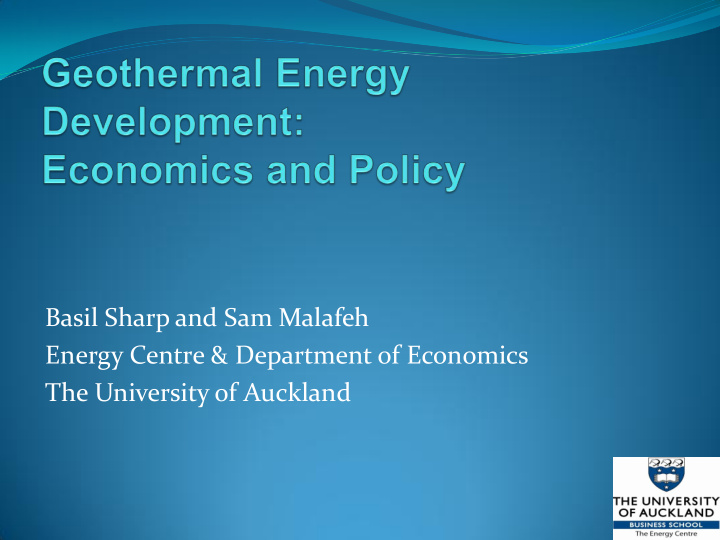



Basil Sharp and Sam Malafeh Energy Centre & Department of Economics The University of Auckland
Outline Focus on electricity Policy Renewables Climate change Property rights RMA Economics Demand, supply Regional economics Concluding comments
Policy: Status Quo
Policy: 90% Renewables
Policy: Projected Geothermal
Policy: Climate Change ETS passed into law 2008 – under review Proposed change: delay entry of stationary energy sources to July 2010 Transition phase: Surrender 1 NZU for every 2 units CO 2 -e or pay $25 Can bank but can’t export while price cap in place Great deal of uncertainty around Copenhagen
Property Rights: RMA Geothermal energy is a renewable resource Councils not to consider effects of climate change but are to have regard to benefits derived from use & development of renewables Councils can set rules limiting GHG emissions Environment Waikato: distinguishes across geothermal systems – Development Geothermal Systems most relevant to electricity
Property Rights: RMA Discretionary activity within Development Geothermal Systems First-in-time basis Rewards first-movers & innovators Race to the pump house? Efficient use? One system multiple operators (Environment Court) Unitisation (single tapper) v. multiple tappers? Incumbent consent holder: access, possible holdout? Multiple operator agreements
Property Rights: RMA Transferable $ Value of property rights A $ Value of property rights B Excludable Duration Quality
Economics Secure & durable rights essential for investment Demand Growth Characteristics Supply into market Timing of development Scale Siting of development Balancing supply and demand
Demand Drivers: economic growth, population, efficiency of use – generally slower than economic growth Expectations: around 1.5-2.5% per year Characteristics: Location: population, climate Peaks mornings & evenings Seasonal demand Average around 8 MWh/household/year
Existing and Proposed Developments: Taupo Region Existing MW Date Notes Wairakei 176 1958 To be phased out as Te Mihi comes on stream Ohaaki 50 1989 Poihipi 30 1996 Rotokawa 35 1997 Mokai 112 2000 Sub-Total 403 Proposed Rotokawa 132 Under construction Tauhara Phase 1 23 Under construction Commission 2010 Te Mihi 220 Consented Expected 2012 Tauhara Phase 2 220 Consent application Ngatamariki 80 Unknown Exploration stage Sub-Total 640 Total (approx.) 1,000 Source: Environment Waikato
Power plant costs Plant size Power Plant 20 MW 50 MW Single pressure condensing $2,200/kW $1,900/kW Double pressure condensing $2,450/kW $2,100/kW Organic Rankine Cycle $2,700/kW $2,700/kW Hybrid steam & Organic Rankine $2,600/kW $2,200/kW Binary Source: SKM (2009) Note: Costs are in 2007 NZ dollars
Capital cost, plant size and temperature Plant size Plant Type 20 MW 50 MW o C 230 o C 260 o C 260 o C 300 o C Single flash $5,550/k $5,350/k $4,300/k $3,750/k W W W W Hybrid cycle $5,850/k $5,800/k $4,450/k $4,050/k W W W W Source: SKM (2009) Note: Costs are in 2007 NZ dollars
Balancing supply and demand Bid price Demand $/MWh B J B A MWh
Prices: Wairakei Plant 2000 – April 2009
Regional economics Regional & local impacts Capturing benefits: Local infrastructure and business Depends on scale, source of materials Agreements with land owners Employment opportunities Typically use multipliers to capture expected employment during construction & operation Income Multipliers Agreements with local community to derive employment, income, education, …, benefits
Concluding Comments Policy Geothermal as a renewable: Reliable & sustainable Challenges facing wind: intermittent supply, consent (Lamermoor decision) Climate change: investment option Resource Management Act Quality of consents Managing externalities Development Demand growth ~ 1-2% per year Is scale and timing efficient?
Recommend
More recommend